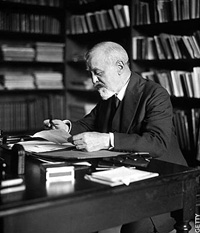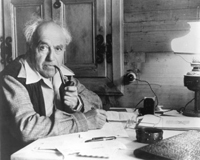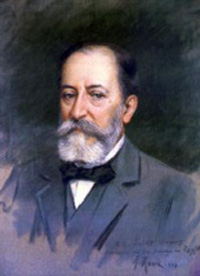| SAINT-SAňNS – ORGAN SYMPHONY | ||||||||||
Fanfare from La péri Known to audiences in this country by a single work, The Sorcerer's Apprentice – and that especially via the famous Disney animation with Mickey Mouse in the film Fantasia – Paul Dukas was a pathological perfectionist, who burned all but a dozen of his compositions. Besides La Péri, his major surviving works are the Symphony in C and the opera Ariane et Barbe-Bleue (Ariadne and Bluebeard). His ballet La péri nearly ended up in the fireplace as well, surviving only at the insistence of friends. Composed in 1911 it was Dukas’ final published work. The ballet is based on a Persian story about Iskender (Alexander the Great) and the péri, a fairy in the service of Ormuzd, god of light. Dukas originally intended La péri for Diaghilev’s Ballets Russes – the company that premiered Stravinsky’s Petrushka, The Firebird and The Rite of Spring – but the deal fell through because of infighting about the casting. Dukas’s music reflects the composer’s seemingly incompatible admiration for Wagner and French impressionism. The opening Wagner-on-the-Seine brass fanfare, which Dukas added to the ballet as an afterthought, imitates the fanfare Wagner wrote expressly to summon the audience after the intermission at his music dramas at the Bayreuth Festspielhaus.  | ||||||||||
Concerto Grosso No. 1 Compared to his contemporaries, Schoenberg or Stravinsky, Swiss composer Ernest Bloch must be considered conservative. Although he did not shy away from such modern techniques as serialism, the intensity and passion in much of his work harks back to the more traditional era of his youth. He avoided "schools" and was careful to allow his many students – among them such well-known figures as Roger Sessions, Quincy Porter, Leon Kirchner and George Antheil – to use their own gifts and express themselves in their own personal way. The son of a clock maker, Bloch spent a good part of his creative life in America, studied violin and composition in Switzerland, Belgium (where he studied violin with famed violinist Eugène Ysaˇe), France and Germany then returned to Geneva where he entered the family's business as bookkeeper. Teaching and composing on the side, he tried to establish a conducting career. Bloch visited the United States in 1916 as conductor for a tour by the Maud Allan dance company. When the tour failed and he was stranded, he accepted a position teaching theory and composition at the newly formed David Mannes College of Music in NY. In the following years Bloch established and maintained an important career as an educator, with posts that included first Directorship of the Cleveland Institute of Music, and then Director of the San Francisco Conservatory. He spent most of the 1930s in Switzerland, composing and conducting his music. He returned to the USA in 1940 to teach composition at Berkeley until his retirement in 1952. Although there is no record of Bloch having crossed paths with his contemporary, painter Marc Chagall, the two artists derived much of their creative inspiration from Jewish sources. Bloch’s music was inspired by Old Testament subjects or from Jewish traditional life. While he seldom quoted directly from Hebrew traditional and religious melodies, the influence of cantoral chants appears in many of his scores, although without literal imitation. He once said, "I do not propose or desire to attempt a reconstruction...or to base my work on melodies more or less authentic. I am not an archaeologist...It is rather the Hebrew spirit that interests me..." The Concerto Grosso No. 1, however, was a purely secular exception. Bloch composed it in Cleveland in 1925 as a piece for the student orchestra. It was his response to the doubts of some students that a meaningful work could still be written in such a traditional style. According to the composer's daughter, Suzanne, they “were skeptical when Bloch told them that one could still write alive and original music with the means that had existed for so long.” The first movement Prelude and final movement Fugue proved his point. Typical of the Baroque concerto, the movements are structured around a ritornello that recurs throughout the movement with short episodes of new music. The first, Prelude: Allegro energico e pesante, is something of an introduction, structured around the following ritornello.  The second movement Dirge: Andante moderato, is considerably longer and composed in the standard ternary (ABA) form of slow movements since the Baroque. Still built around a single ritornello,  a brief signing motive provides a contrast in texture. a brief signing motive provides a contrast in texture.  The middle section retains the mood. The middle section retains the mood.  The third movement, Pastorale and Rustic Dances, breaks away somewhat from the Baroque prototype. The mysterious introduction  hints at the dance to come. hints at the dance to come.  But the movement alternates between the two tempi, combining all the themes together contrapuntally in a majestic conclusion. But the movement alternates between the two tempi, combining all the themes together contrapuntally in a majestic conclusion.  Of course, no proper Baroque concerto can get away without a fugue. The final movement, Fugue, is Bloch’s Bachian bonanza. Right off the block (no pun), the subject contains within it is canon at the unison and the first motive in inversion.  Only after the violas and violins get through that little piece of Bach-like contrapuntal cleverness do the cellos and basses enter with the proper response at the appropriate interval. Only after the violas and violins get through that little piece of Bach-like contrapuntal cleverness do the cellos and basses enter with the proper response at the appropriate interval.  A joyous middle section introduces another fugue. A joyous middle section introduces another fugue.  Bloch continues to indulge in more contrapuntal games, including combining the two themes, running them upside down and backwards, in augmentation, adding more canons, and slipping in the themes from the first movement – just like the master! Bloch continues to indulge in more contrapuntal games, including combining the two themes, running them upside down and backwards, in augmentation, adding more canons, and slipping in the themes from the first movement – just like the master! | ||||||||||
Symphony No. 3 in C minor, Op. 78, “Organ Symphony” Composer, organist and pianist Camille Saint-SaŽns was phenomenally precocious and gifted in everything he undertook. He was a man of wide culture, well versed in literature, the arts and scientific developments. As a child prodigy he wrote his first piano compositions at age three and at age ten made his formal debut at the Salle Pleyel in Paris, playing Mozart and Beethoven piano concertos. In his youth he was considered an innovator, but by the time he reached maturity he had become a conservative pillar of the establishment, trying to maintain the classical musical tradition in France and expressing open disdain for the new trends in music, including the “malaise” of Wagnerism. He premiered his five piano concertos with impeccable technique and effortless grace. But neither his compositions nor his pianism were ever pinnacles of passion or emotion. Berlioz noted that Saint-SaŽns “...knows everything but lacks inexperience.” Saint-SaŽns was a consummate craftsman and a compulsive worker. “I produce music the way an apple tree produces apples,” he commented. He was a proponent of “art for art's sake” but his views on expression and passion in art conflicted with the prevailing literary and emotive Romantic ideas. He wrote in his memoirs: “Music is something besides a source of sensuous pleasure and keen emotion, and this resource, precious as it is, is only a chance corner in the wide realm of musical art. He who does not get absolute pleasure from a simple series of well-constructed chords, beautiful only in their arrangement, is not really fond of music.” And also: “Beware of all exaggeration.” His output is large and diverse, including chamber works for most orchestral instruments. Although his music was often perceived as passé, he was the first composer to write an original film score in 1908 for L’assassinat du Duc de Guise (The assassination of the Duke of Guise). Saint-SaŽns professed to uphold the classical virtues of clarity, restraint and elegance, but none of these virtues appear in the C minor Symphony, a romantic work with colorful and grandiose orchestration throughout. The organ part is integrated into the orchestra and does not emerge as a solo counterforce, as in a concerto. Appropriately, Saint-SaŽns dedicated it to the memory of Franz Liszt, whose virtuosic organ music served as his model. The symphony was commissioned by the London Philharmonic Society and premiered by that orchestra in May 1886 with the composer conducting from the keyboard. There is thematic interconnection between the Symphony's movements, and the traditional four movements are fused into two: “[the Symphony] embraces in principle the four traditional movements, but the first, halted in its development, serves as introduction to the Adagio, while the Scherzo is abandoned by the same process to lead to the Finale,” the composer wrote. Saint-SaŽns borrowed from Liszt the technique of thematic transformation in which a single theme, or motto, recurs in various guises as an essential unifying device. But despite his insistence that the Symphony is a two-movement work, it is easier to think of it as having four movements since there are four distinctly discernible sections each with its own mood and musical structure. A brief slow introduction hint at the motto in the solo oboe and flute. The following Allegro immediately presents the motto in hushed, stuttering strings,  creating an anxious tension that pervades even the lilting second theme. creating an anxious tension that pervades even the lilting second theme.  The Allegro comprises a continuous stream of transformations of the motto and via a reprise of the introduction, the movement blends into the Poco Adagio without pause. This is the first appearance of the organ accompanying an expansive new melody in the lower strings The Allegro comprises a continuous stream of transformations of the motto and via a reprise of the introduction, the movement blends into the Poco Adagio without pause. This is the first appearance of the organ accompanying an expansive new melody in the lower strings  . After a few minutes, the motto quietly returns, eventually combining with the Adagio melody, . After a few minutes, the motto quietly returns, eventually combining with the Adagio melody,  where it is played pizzicato by the basses and cellos. where it is played pizzicato by the basses and cellos.  The stuttering rhythm returns in the third movement with a new theme, but is immediately accompanied by the first movement theme and a return to the ominous mood of the opening.  The Trio, yet another iteration of the first movement theme, makes a surprising introduction of the piano into the orchestral mix. The Trio, yet another iteration of the first movement theme, makes a surprising introduction of the piano into the orchestral mix.  The movement ends on a serene note, with the first movement theme now in the major mode, anticipating the final movement. The movement ends on a serene note, with the first movement theme now in the major mode, anticipating the final movement.  After a grand entrance on the organ, the strings, accompanied by the piano, transform the first movement theme into a majestic chorale.  Saint-SaŽns even creates a fugue for it in its new guise. Saint-SaŽns even creates a fugue for it in its new guise.  In a sense, the Symphony No. 3 can be understood as a musical drama, in which a protagonist (the first movement theme) eventually triumphs over adversity. Over the top? Perhaps, but then, Saint-SaŽns dedicated his Symphony to one of the nineteenth century's more melodramatic composers. In a sense, the Symphony No. 3 can be understood as a musical drama, in which a protagonist (the first movement theme) eventually triumphs over adversity. Over the top? Perhaps, but then, Saint-SaŽns dedicated his Symphony to one of the nineteenth century's more melodramatic composers. | ||||||||||
| Copyright © Elizabeth and Joseph Kahn 2016 | ||||||||||


